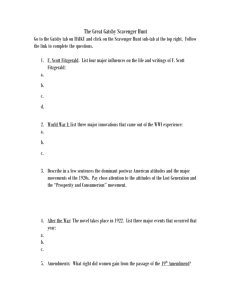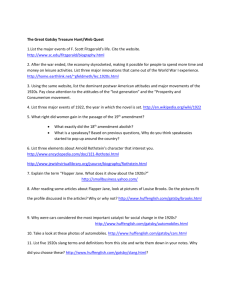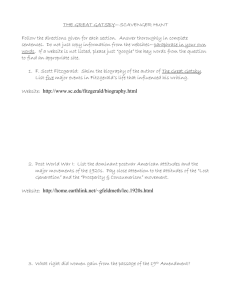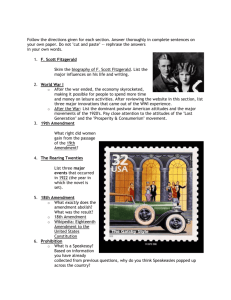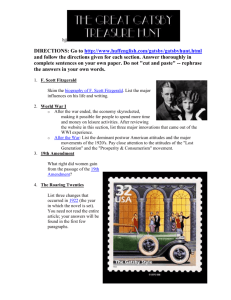The_Great_Gatsby_Scavenger_Hunt (1)NEW
advertisement
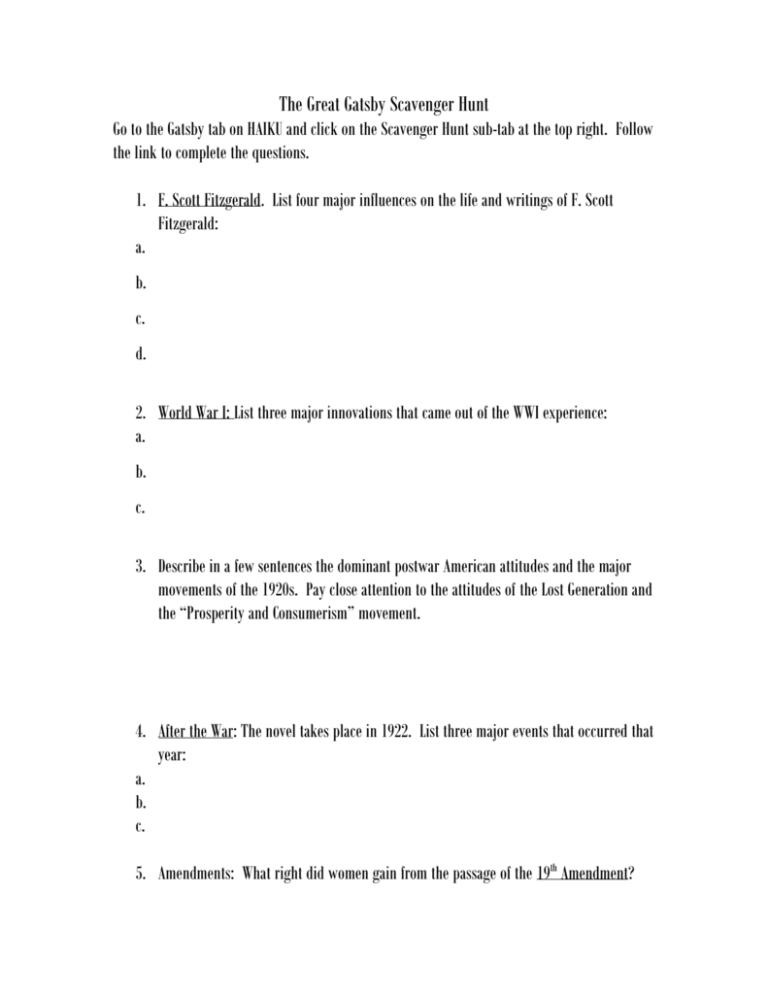
The Great Gatsby Scavenger Hunt Go to the Gatsby tab on HAIKU and click on the Scavenger Hunt sub-tab at the top right. Follow the link to complete the questions. 1. F. Scott Fitzgerald. List four major influences on the life and writings of F. Scott Fitzgerald: a. b. c. d. 2. World War I: List three major innovations that came out of the WWI experience: a. b. c. 3. Describe in a few sentences the dominant postwar American attitudes and the major movements of the 1920s. Pay close attention to the attitudes of the Lost Generation and the “Prosperity and Consumerism” movement. 4. After the War: The novel takes place in 1922. List three major events that occurred that year: a. b. c. 5. Amendments: What right did women gain from the passage of the 19th Amendment? 6. What exactly did the 18th Amendment abolish? What was the result? 7. Prohibition: What is a Speakeasy? Why do you think Speakeasies popped up across the country during this time? 8. What’s in a Name: Arnold Rothstein was a notorious leader in organized crime. What is organized crime? 9. What’s in a Name: List three elements about Arnold Rothstein’s character that interest you. Explain why they interest you. a. b. c. 10. The Organizer: Read the quotes at the beginning of the site about Rothstein. What is his primary occupation? What are his “side jobs”? Did your impression of Rothstein change from one web page to the next? Explain. 11. Flappers: Read the first five paragraphs of the article about “Flapper Jane.” According to the author, what are the essential elements of being a true flapper? UNDERLINE and be ready to discuss. By Bruce Bliven Originally published in the September 9, 1925 edition of The New Republic. Jane’s a flapper. That is a quaint, old-fashioned term, but I hope you remember its meaning. As you can tell by her appellation, Jane is 19. She urgently denies that she is a member of the younger generation. The younger generation, she will tell you, is aged 15 to 17; and she professes to be decidedly shocked at the things they do and say. This is a fact which would interest her minister, if he knew it – poor man, he knows so little! For he regards Jane as a perfectly horrible example of youth–paint, cigarettes, cocktails, petting parties–oooh! Yet if the younger generation shocks her as she says, query: how wild is Jane? Before we come to this exciting question, let us take a look at the young person as she strolls across the lawn of her parents’ suburban home, having just put the car away after driving sixty miles in two hours. She is, for one thing, a very pretty girl. Beauty is the fashion in 1912. She is frankly, heavily made up, not to imitate nature, but for an altogether artificial effect—pallor mortis, poisonously scarlet lips, richly ringed eyes—the latter looking not so much debauched (which is the intention) as diabetic. Her walk duplicates the swagger supposed by innocent America to go with the female half of a Paris Apache dance. And there are, finally, her clothes. These were estimated the other day by some statistician to weigh two pounds. Probably a libel; I doubt they come within half a pound of such bulk. Jane isn’t wearing much, this summer. If you’d like to know exactly, it is: one dress, one step-in, two stockings, two shoes. A step-in, if you are 99 and 44/100ths percent ignorant, is underwear—one piece, light, exceedingly brief but roomy. Her dress, as you can’t possibly help knowing if you have even one good eye, and get around at all outside the Old People’s Home, is also brief. It is cut low where it might be high, and vice versa. The skirt comes just an inch below her knees, overlapping by a faint fraction her rolled and twisted stockings. The idea is that when she walks in a bit of a breeze, you shall now and then observe the knee (which is not rouged—that’s just newspaper talk) but always in an accidental, Venus-surprised-at-the-bath sort of way. This is a bit of coyness which hardly fits in with Jane’s general character. Jane’s haircut is also abbreviated. She wears of course the very newest thing in bobs, even closer than last year’s shingle. It leaves her just about no hair at all in the back, and 20 percent more than that in the front–about as much as is being worn this season by a cellist (male); less than a pianist; and much, much less than a violinist. Because of this new style, one can confirm a rumor heard last year: Jane has ears. 11. Read Dorothy Parker’s poem “The Flapper.” Do you think the poet approves or disapproves of flappers? Explain. 12. Automobiles: Why were cars considered the “most important catalyst for social change in the 1920s”? 13. 1920s Slang: read some 1920s slang terms. List five slang words or phrases and write them down. Why did you choose these? What slang terms that you use today are they similar to? a. b. c. d. e. 14. Video: Look at the trailers for the Great Gatsby movies. What do you expect based on the scenes from the trailers? 18. Based on the information you have collected, what do you think The Great Gatsby will be about?
